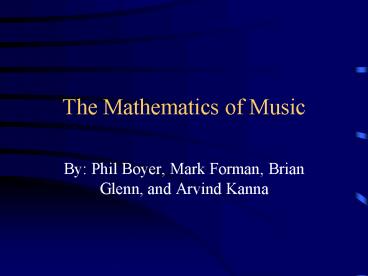The Mathematics of Music - PowerPoint PPT Presentation
1 / 17
Title: The Mathematics of Music
1
The Mathematics of Music
- By Phil Boyer, Mark Forman, Brian Glenn, and
Arvind Kanna
2
What is a harmonic?
- Any of a series of musical tones whose
frequencies are integral multiples of the
frequency of a fundamental tone - A wave whose frequency is a whole number multiple
of that of another
3
frequencies
4
Harmonic Series
- This series Diverges.
- For each whole number a harmonic exists.
- In music, only the odd harmonics sound pleasing
to the ear.
5
EAR
6
Structure of Human Ear
- Sounds travel through the ear by way of the
cochlea and basilar membrane
7
Why Sine Waves?
- Sine waves most accurately model how a sound
particle travels through the ear. - The equation that best represents how musical
sound waves travel through the ear is the
equation for simple harmonic motion
8
Simple Harmonic Motion
9
Vibrating strings
10
Vibrating Strings Equation
- n is the value of the harmonic being played.
11
Musical Scale
- The Western Musical Scale consists of twelve
notes forming an octave. - There are 7 natural notes and 5 sharp/flat notes.
- means sharp, b means flat
- A A B C C D D E F F G G
- A Bb B C Cb D Eb E F Gb G Ab
12
Musical Harmonies
- There are many musical harmonies that can be
played on guitar or any instrument for that
matter. - Harmonies can be played between different types
of instruments. - Most popular artists use harmonies in their
songs. Even samples and electronic beats use
them.
13
(No Transcript)
14
Why Do Mathematical PeopleExcel in Music?
- 1. generally this is so because of the mind set
and thought, which is similar between both
subjects. - 2. math as a subject is generally about thinking,
problem solving, seeing patters. - 3. math is also about working with what you know
to find a method of exploring and understanding
new concepts. - 4. Music is very similar to math in this sense.
15
- 5. Arranging a melody on an instrument and
finding fingerings that correspond to certain
sequences of notes(like piano for example) is
definitely a type of math problem. - 6. Playing the same melody on different
instruments is math, as is playing a stringed
instrument and changing the tuning.
16
- 7. Playing harmonies, playing the same song in
different keys--these things all involve
recognizing the structure of a piece of music. - 8. Good musicians can often listen to a song,
observe the musical structure, and play along
with it, without really knowing it or rehearsing
it, because they recognize familiar patterns. - 9. this type of pattern recognition and mind set
of math oriented individuals helps them excel in
music.
17
Bibliography
- Dave, Benson. "Music A Mathematical Offering."
Mathematics and Music. 14 May 2006. Cambridge
University. 25 May 2006 lthttp//www.maths.abdn.ac.
uk/bensondj/html/maths-music.htmlgt. - Harrison, David M. "Standing Waves." 24 Mar.
2003. University of Toronto. 25 May 2006
lthttp//www.upscale.utoronto.ca/GeneralInterest/Ha
rrison/Vibrations/Vibrations.htmlgt. - Reid, Harvey. "On Mathematics and Music."
Woodpecker Records. Nov. 1995. Woodpecker
Records. 25 May 2006 lthttp//www.woodpecker.com/wr
iting/essays/mathmusic.htmlgt.































